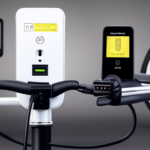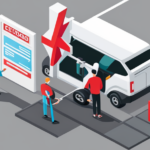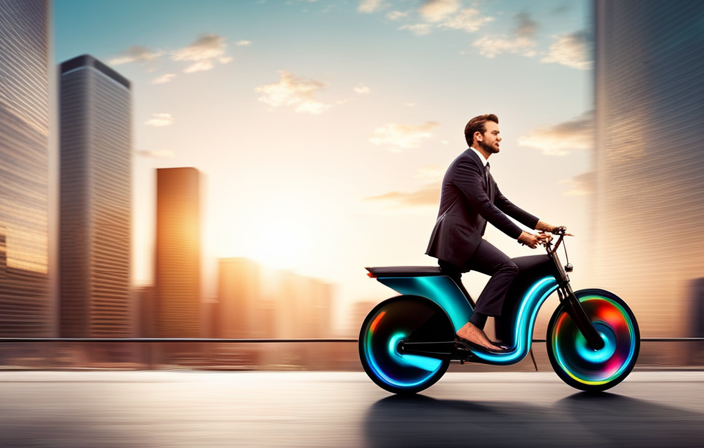Picture this: You are all set to take your electric mini bike out for a ride, but there is one issue – it won’t charge. Quite frustrating, isn’t it?
However, fear not, as I’ll guide you through the process of fixing this issue step by step. In this article, we’ll explore troubleshooting techniques, such as checking the power source, testing the battery, and inspecting the charging cable.
By the end, you’ll have the know-how to get your electric mini bike up and running again.
Key Takeaways
- Use the correct charger designed for the battery
- Check battery connections and charging port for damage or looseness
- Troubleshoot low voltage issues by trying a different charger and testing voltage levels
- Inspect fuse and circuit breaker for damage and reset if necessary
Check the Power Source
You should check if the power source is working properly.
When troubleshooting charging problems with your electric mini bike, it’s important to start by ensuring that the power source is functioning correctly.
Begin by verifying that the outlet or power socket is receiving electricity by plugging in another device. If the alternate device works, then the power source is not the issue.
In this case, move on to inspecting the charging cable.
However, if the outlet does not provide power, try resetting the circuit breaker or replacing the fuse. Additionally, check for any loose connections or damaged wiring that may be affecting the power supply.
By systematically eliminating potential power source issues, you can narrow down the cause of your mini bike’s charging problem.
Inspect the Charging Cable
Inspecting the charging cable is an important step in troubleshooting an electric mini bike that is not charging. To begin, visually examine the charging cable for any signs of damage, such as frayed wires or exposed insulation. If you notice any issues, it is crucial to replace the damaged charging cable with a new one to ensure proper charging functionality.
Additionally, check for loose connections at both ends of the cable, ensuring they are securely plugged into the bike’s charging port and the power source. Tightening any loose connections may resolve the charging issue.
Once the charging cable has been inspected and any necessary repairs or replacements have been made, it is time to move on to the next step: testing the battery’s functionality.
Test the Battery
After inspecting the charging cable, it’s time to test the functionality of the battery.
To begin, check the battery voltage using a multimeter. Connect the positive lead of the multimeter to the positive terminal of the battery and the negative lead to the negative terminal. A fully charged battery should have a voltage reading between 12.6 and 12.8 volts. If the voltage is significantly lower, it may indicate a depleted or faulty battery.
Additionally, assess the battery capacity by using a battery tester. This device measures the amount of charge the battery can hold. A healthy battery should have a capacity close to its rated capacity.
If the battery voltage and capacity are within the acceptable range, proceed to clean and tighten connections, ensuring a secure and efficient electrical connection throughout the mini bike.
Clean and Tighten Connections
To ensure proper electrical connections, make sure to clean and tighten all connections on your mini bike. Start by inspecting the charging port to ensure it is clean and free from any debris or corrosion. Use a small brush or compressed air to remove any dirt or dust that may be blocking the connection. Next, clean the battery terminals by gently scrubbing them with a battery terminal cleaner or a mixture of baking soda and water. This will remove any built-up corrosion and ensure a solid connection. After cleaning, tighten all the connections to ensure they are secure. A loose connection can prevent the battery from charging properly. Once all the connections are cleaned and tightened, you can proceed to the next step of replacing any faulty components.
To replace faulty components, refer to the manufacturer’s instructions or consult a professional if needed.
Replace Faulty Components
Once all the connections are cleaned and tightened, it’s time to replace any faulty components on your mini bike.
To start, carefully inspect the entire charging system for any damaged parts. This includes the battery, charger, and wiring. Look for any visible signs of wear or damage such as frayed wires or cracked components.
If you find any faulty parts, they will need to be replaced with new ones. It’s important to choose the correct replacement components that are compatible with your mini bike’s make and model. If you’re unsure, consult the manufacturer’s manual or seek assistance from a professional.
By replacing the faulty components, you can ensure that your mini bike’s charging system functions properly.
Now, let’s move on to the next step of resetting the charging system.
Reset the Charging System
To reset the charging system on your mini bike, follow these steps:
-
Disconnect the charger from the battery and unplug it from the power source.
-
Check for any loose connections or damaged wires in the charging system. Ensure all connections are secure and tight.
-
If you notice any faulty components, refer to the previous subtopic and replace them accordingly.
-
Once you’ve inspected and fixed any issues, reconnect the charger to the battery and plug it back into the power source.
-
Allow the battery to charge for the recommended amount of time.
If the problem persists, it may be necessary to seek professional assistance. They have the expertise and tools to diagnose and resolve more complex charging problems.
Seek Professional Assistance
If the issue persists, it might be best to consult a professional for assistance. Seeking alternatives in troubleshooting your electric mini bike is crucial when faced with a charging problem. However, sometimes the issue may be beyond our capabilities, and seeking professional help becomes necessary.
Here are four reasons why consulting a professional is a wise decision:
-
Expertise: Professionals have the knowledge and experience to diagnose and fix complex electrical issues with precision.
-
Safety: Dealing with electrical components can be dangerous, and professionals have the necessary tools and precautions to ensure your safety.
-
Efficiency: Professionals can quickly identify the root cause of the problem and provide a faster solution, saving you time and effort.
-
Warranty: If your mini bike is still under warranty, seeking professional assistance ensures that the repairs are done correctly, maintaining the warranty coverage.
By consulting a professional, you can explore all available options before considering upgrading the battery.
Consider Upgrading the Battery
Consider upgrading the battery to improve the charging performance of your electric mini bike.
When it comes to upgrade options, there are a few factors to consider. First, determine the voltage and capacity requirements of your electric mini bike. This will help you find a compatible battery with higher performance capabilities.
Lithium-ion batteries are a popular choice due to their lightweight and high energy density. They offer improved battery performance and longer lifespan compared to traditional lead-acid batteries.
Additionally, consider the charging time and compatibility with your bike’s charging system. Upgrading to a fast-charging battery or one that is compatible with your existing charger can greatly improve the charging efficiency.
By upgrading the battery, you can enhance the overall performance and range of your electric mini bike.
Moving on to the subsequent section about ‘maintain regular battery care,’ it is essential to ensure the longevity and optimal performance of your upgraded battery.
Maintain Regular Battery Care
Taking proper care of your upgraded battery is crucial for maintaining its longevity and optimal performance. The importance of proper storage for electric bike batteries cannot be overstated.
When not in use, it is essential to store the battery in a cool, dry place, away from direct sunlight and extreme temperatures. This will help prevent damage and extend its lifespan.
Additionally, it is important to avoid common mistakes when charging electric bike batteries. Always use the charger specifically designed for your battery and follow the manufacturer’s instructions. Avoid overcharging the battery, as this can lead to overheating and reduce its overall capacity. Furthermore, never leave the battery charging unattended or overnight.
By following these guidelines, you can ensure the proper care and maintenance of your upgraded battery.
Now, let’s troubleshoot other possible issues.
Troubleshoot Other Possible Issues
To troubleshoot other possible issues, you can start by checking the connections of your upgraded battery to ensure they are secure and properly aligned. Make sure the charging port is not damaged or loose. Inspect the wires for any signs of wear or fraying.
Next, use a voltmeter to check the voltage output of the battery. It should be within the recommended range for your electric mini bike. If the voltage is too low, it could indicate a problem with the battery or charger. Try charging the battery with a different charger to see if that resolves the issue.
Additionally, check the fuse and circuit breaker to ensure they are not blown or tripped. If all else fails, consult the manufacturer or a professional electric bike technician for further assistance.
Frequently Asked Questions
How do I know if my electric mini bike is not charging?
To determine if an electric mini bike is not charging, check the battery connections for loose or corroded terminals. Test the battery voltage with a multimeter to ensure it is within the recommended range. If necessary, consult the owner’s manual for further troubleshooting steps.
What should I do if the power source is working fine but my electric mini bike still won’t charge?
First, I would perform troubleshooting steps to identify the issue. Then, I would check the battery connections for any loose or corroded wires. These steps will help determine why the bike is not charging.
Can a faulty charging cable prevent my electric mini bike from charging?
Yes, a faulty charging cable can prevent an electric mini bike from charging. Troubleshooting the charging cable is essential when encountering common charging issues. Ensure the cable is not damaged or worn, and check for any loose connections or faulty wiring.
What are some common signs of a battery issue in an electric mini bike?
Common signs of a battery issue in an electric mini bike include decreased performance, difficulty starting, and a rapidly draining battery. Troubleshooting steps involve checking for loose connections, inspecting the battery for damage, and testing the voltage output.
How often should I clean and tighten the connections on my electric mini bike to ensure proper charging?
I clean and tighten the connections on my electric mini bike every 3 months to ensure proper charging. It’s one of the best practices for maintaining battery life. Additionally, using a battery tender provides benefits like preventing overcharging and maintaining optimal battery health.
Conclusion
In conclusion, fixing an electric mini bike that refuses to charge can be a challenging task. However, by following the steps mentioned above, you can troubleshoot and resolve the issue effectively.
Remember the old saying, ‘A stitch in time saves nine.’ Regular maintenance, careful inspection, and seeking professional help when necessary will ensure a smooth and reliable riding experience.
Don’t hesitate to upgrade the battery if needed and always prioritize proper battery care.
Stay diligent, and you’ll have your mini bike up and running in no time.
















